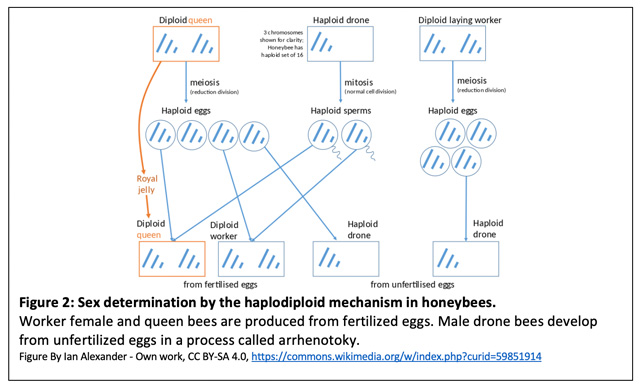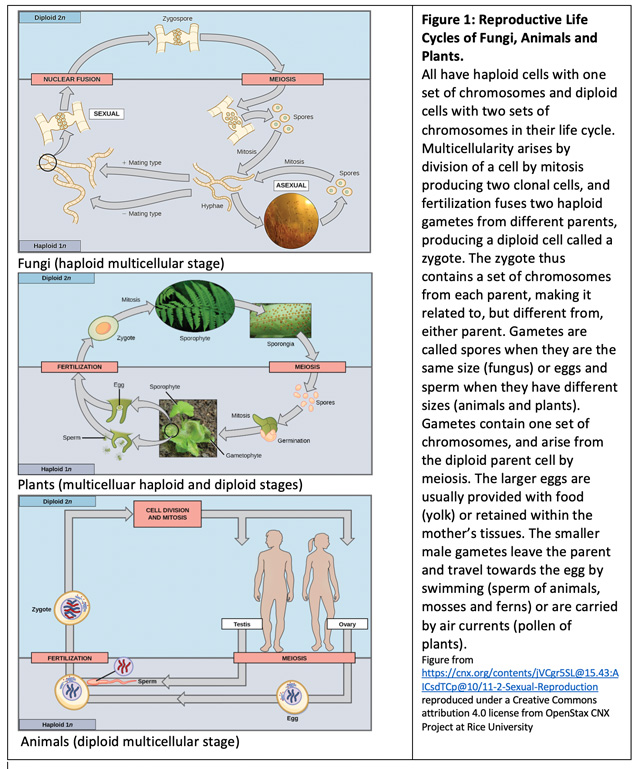By Vidya Rajan, Columnist, The Times
Reproduction is the process by which cells make new cells and organisms make babies. No surprises there. But underlying the banality of that observation is a profound question that had thinkers from Aristotle to Darwin scratching their heads: How does reproduction work? How is it that cats have baby cats nearly, but not exactly, like themselves? And if cats make baby cats nearly like themselves, why are all cats not nearly the same? How come there are so many cat variations: lions, snow leopards, civets, and the moggy who is currently hogging your comfy armchair? This conundrums stymied understanding of reproduction until quite recently. Here, I will review the general principles and purposes of reproduction from an evolutionary standpoint which explains the contradiction above.
There are three basic principles to reproduction. 1. Reproduction can occur asexually or sexually. In terms of their effectiveness, think about tactics (short term) versus strategy (long term). Asexual reproduction highlights the short-term importance of longevity of the individual, and sexual reproduction focuses on strategy of survival of the species by introducing variety. 2. Sexual mating options are cross-fertilization or self-fertilization. Cross fertilization is best and is practiced by most organisms, but some organisms live in sparse populations where finding a partner can be difficult. Hermaphrodite reproduction where the same individual makes both sperm and eggs, or a type of parthenogenesis called thelotoky, where a single, virgin female can produce offspring without mating, are solutions to this problem. 3. Fertilization and development can be external or internal. Many organisms live on dry land where delicate eggs and sperm can dessicate, and these organisms have to adapt their strategies to prevent their drying out. Some strategies include placing the embryo in a moist environment, internal fertilization where sperm is deposited inside the female whose body protects the embryo, and waterproofing to prevent the embryo from drying out on land. I will examine each of these principles in more detail below.
Asexual reproduction produces clonal cells and is the most prevalent form of reproduction. Some living things like bacteria and fungi primarily reproduce and produce offspring asexually. Our body’s cells reproduce clonally too, from the time of conception onwards. [Note: The differences between body parts is just a matter of which a subset of the genes in the genome is being expressed there.] In general terms, clonal reproduction is very successful in situations where the parent is well adjusted to the environment; the offspring will also be well adapted since they have the same genes. Clonal reproduction is not effective for longer-term species success, because changes in the environment such as the introduction of new predators or sudden, adverse environmental conditions will pose a challenge that the existing gene collection within clonal individuals cannot meet. The identical individuals of that species will struggle for survival in an identical manner and the species will go extinct if they are unsuccessful. Although it is quick and easy with great rewards in good times, clonal reproduction is a high-risk strategy. The great Irish Potato famine in the 1840s, which killed 1 in 8 Irish and forced 2 million people to emigrate, was the consequence of propagating a single clone of a tasty potato across the nation, which unfortunately turned out to be susceptible to potato blight [1]. The potato crop across the nation was wiped out, precipitating starvation.
The purpose of sexual reproduction is to shuffle up the genome, making new gene combinations in the process. This shuffling does not have to happen exclusively by sexual reproduction. DNA containing one or a few genes can be transferred between organisms in the same generation in a process called horizontal gene transfer (HGT). HGT is how antibiotic resistance spreads in a population of bacteria. [Note: It should be noted that some bacteria “conjugate” and transfer DNA directly from cell to cell, which is considered sexual reproduction.] Mostly, HGT does not meet the definition of sexual reproduction, so I will not consider HGT further except to say that the “exchange” of DNA fragments appears to be happening more widely than previously thought and has had a profound impact on evolutionary success. If you are interested, check out the reviews in [2, 3]. Not only is this interesting as an evolutionary mechanism, it is also how genetic engineering introduces new traits by transferring genes from one organism into another.
Traditional sexual reproduction requires two gamete (reproductive) cells – egg and sperm – from different parents which fuse to produce an offspring that is different from either parent while being related to both. The process by which eggs and sperm, each containing one half of the parent’s genome, is made by an intricate process called meiosis which shuffles genes between chromosome pairs, and chromosome combinations in the gamete by random selection of partners from either parent. The genius of meiosis is that it introduces random variation into gametes, such that no gamete is like any other. When unlike gametes from different parents fuse, the shuffling of genes, chromosomes, and whole genomes brings together in one organism a variety of genes that may find they work better (or worse) together. It’s like a creative cook who marries unusual ingredients to produce novel outcomes: melon and proscuitto (good), and melon and mayo (bad). New gene combinations produce offspring that may successfully navigate environmental challenges that may arise, although they may not even be put to the test! Over time, a large number of differences may accumulate in isolated populations and cause speciation. The presence of just two genders in most organisms is a paradox – it would make more sense to have multiple genders to facilitate more mixing (Note: Fungi overkill with over 20,000 sexes – see https://www.popsci.com/fungi-sex.) Unlike fungi whose gametes are all the same size, gametes of higher animals and plants are of unequal size. Explaining this will require a laying little biology groundwork.
Think of a bacterium – a tiny, tiny thing. Does it have sexes? The answer, surprisingly, is yes. But this “sex” is transferable on a gene which encodes a tube called a sex pilus through which DNA can be transferred from one bacterium into another, a process referred to as “conjugation”. Thus, the bacterium making the sex pilus is designated the male and the one lacking the pilus is the female. Once conjugation occurs, the female acquires the sex pilus gene and becomes a male. But gene shuffling does not occur, only unidirectional gene transfer. Fungi and many protists produce gametes that fuse. The gametes are not distinguishable from each other physically. Since each gamete is different and can fuse with any other, they are all considered different sexes. The fused product is a zygote, which immediately divides by meiosis to make haploid cells which have the potential to become gametes or to grow into multicellular bodies by asexual reproduction.
In land-adapted animals and plants, the gametes are not identical, with male gametes (sperm or pollen) being smaller than female gametes (eggs or ovules). The difference in size arose from the egg providing the cellular organelles and nutrition for the embryo’s sustenance until it can survive on its own. Since it is easier to travel light, the sperm has succumbed to evolutionary pressure to jettison any extra material except the chromosomes and (sometimes) an energy source for movement. [Note: Pollen is a sperm that doesn’t move under its own steam, but is carried by wind or pollinators. Thus, it doesn’t need an additional energy production mechanism such as mitochondria.] When haploid egg and a sperm fuse, they produce a diploid zygote, which goes on to divide to make a body. In animals, the gametes are always unicellular and the bodies are multicellular and grow large. In plants, both the gametes and the bodies are multicellular. This is a fine distinction, but is significant in biological terms (see Figure 1).
Insects are invertebrate animals. Like all animals, the males produce sperm, and the females produce eggs. But the reproductive habits beyond this superficial level are pretty interesting. Males (drones of bees) have many of the same features as fungi – their bodies are haploid and therefore they produce haploid sperm by mitosis much the same way as fungi produce gametes. Although all bee females are diploid, only the queen is fertile. Prior to laying eggs, the queen undertakes a “nuptial flight” in which she is fertilized by several drones who transfer their sperm packets into her spermatheca, where the sperm stay alive for many years. The queen has a neat process by which she controls the release of stored sperm as each egg passes through her oviduct. If the haploid egg is fertilized, then it becomes a diploid female bee. If left unfertilized, the egg becomes a haploid drone, through a process of parthenogenesis (development of an unfertilized egg) technically called arrhenotoky. All females, both workers and queens develop from diploid fertilized eggs (Figure 2). But a queen is made, not born. Female larvae selected to become queens are fed a nutritive secretion called royal jelly throughout their lives and develop to be larger in size than a worker bee. The queen then produces pheromones that suppress reproductive development of other females. In a queenless hive with no suppressing pheromones, a worker can develop the ability to lay eggs, although the stubby worker abdomen prevents the eggs from being laid in the bottom of the long cell.
Finally, some animals demonstrate a fascinating reproductive strategy called thelotoky by which unmated, virgin females can produce fertile female offpspring. In this process, two of the four haploid cells produced by meiosis in the female randomly fuse to make a diploid zygote. Although both the fusing haploid cells arise from the same female parent, each gamete is unique, so the diploid offspring is actually not a clone of the parent. Cape bees (Apis mellifera capiensis), ants, and some lizards use this process to produce fertile female offspring. [Note: This makes males redundant. Males, take note.] Bdelloid rotifers, a type of invertebrate aquatic animal, reproduce exclusively by thelytoky parthenogenesis, and have been male-free for about 80 million years [4]. And they appear to be doing very well, thank you very much.
References
- Goodwin, S.B., B.A. Cohen, and W.E. Fry, Panglobal distribution of a single clonal lineage of the Irish potato famine fungus. Proceedings of the National Academy of Sciences, 1994. 91(24): p. 11591-11595.
- Soucy, S.M., J. Huang, and J.P. Gogarten, Horizontal gene transfer: building the web of life. Nature Reviews Genetics, 2015. 16(8): p. 472.
- Keeling, P.J. and J.D. Palmer, Horizontal gene transfer in eukaryotic evolution. Nature Reviews Genetics, 2008. 9(8): p. 605.
- Pouchkina-Stantcheva, N.N., et al., Functional divergence of former alleles in an ancient asexual invertebrate. Science, 2007. 318(5848): p. 268-271.





